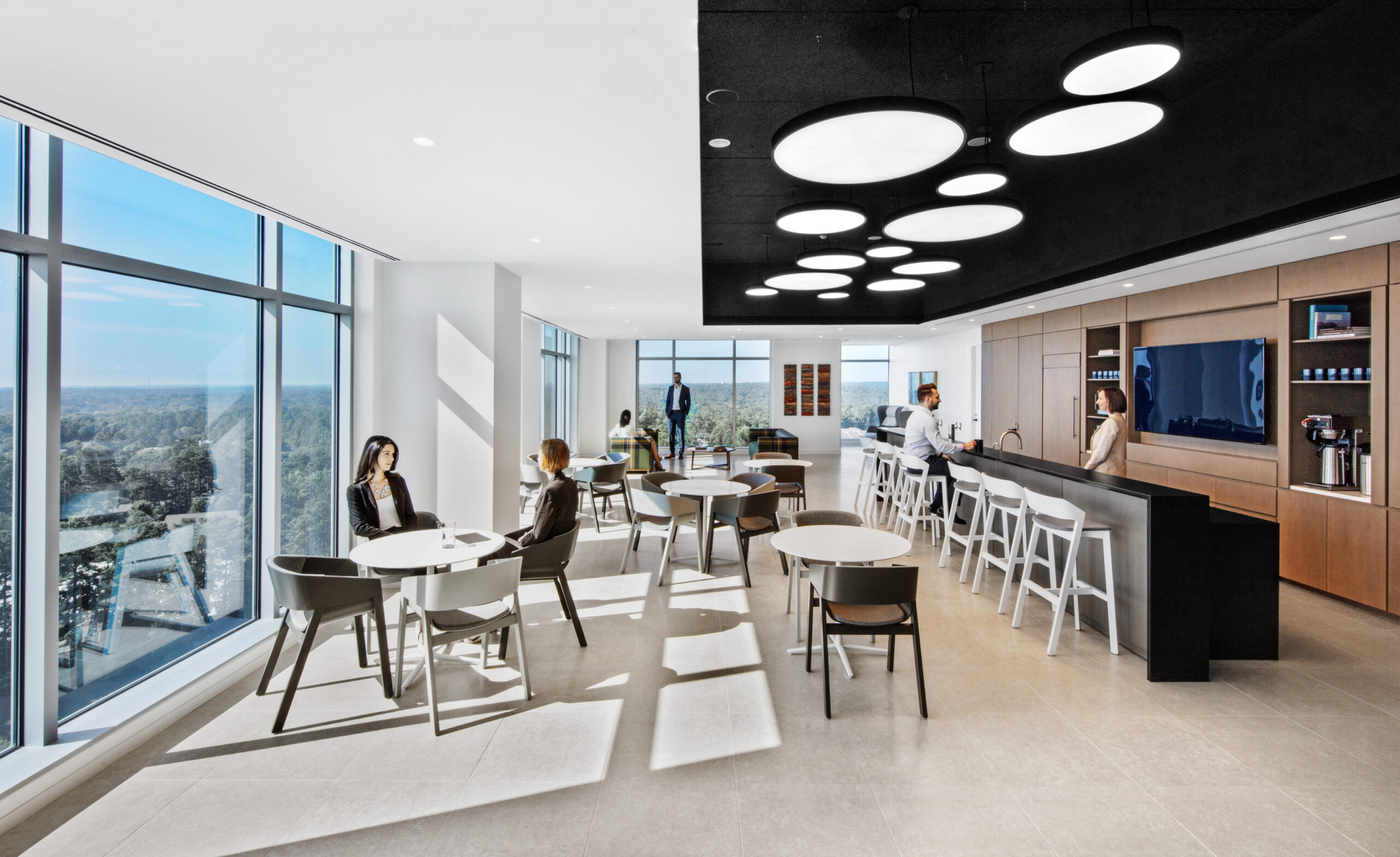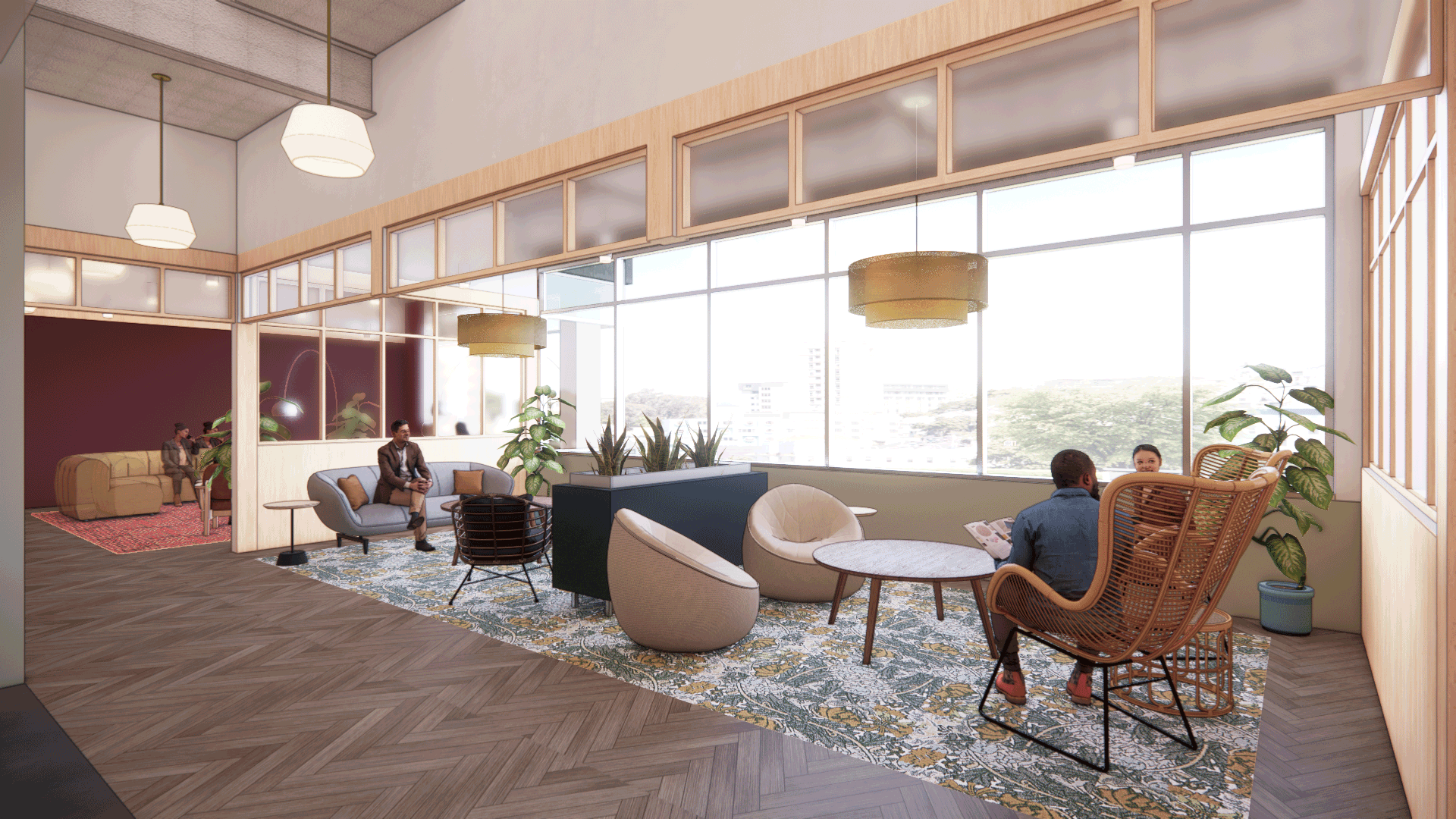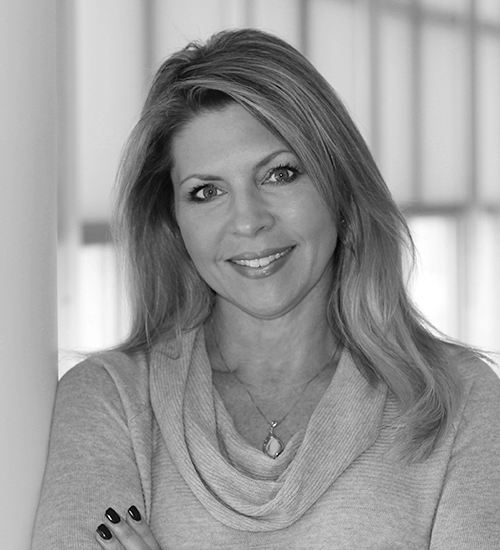Designing for Under the Radar
By Laura Vierling MCR, IIDA, LEED AP, PROSCI CP; Colin O'Malley LEED AP; Kristi Buchler AIA; and Mark Heaviland NCARB, LEED AP

Due to security restrictions, we are precluded from taking photographs of SCIFs. The images included are examples of spaces with plentiful daylight, views to the outdoors and a coffee bar that should ideally greet users stepping out of a SCIF · Confidential Client · Raleigh, NC · Eric Laignel Photography
What is a SCIF?
A SCIF (Sensitive Compartmented Informational Facility) is the US Department of Defense name for a secure space designed and built to guard against electronic surveillance and exposure of sensitive military or other industry data and information requiring high security. Designed and built according to US government exacting standards (the Department of National Intelligence has established the security requirements), SCIF walls, floors, and ceilings are composed of specific layered-material assemblies that block sound and electronic signals from leaving or entering the space. Among other features, doors are equipped with special combination locks and deadbolts, heating and ventilation ducts contain security measures, and there may be non-opening windows with visual and acoustic protection (and alarms if lower than 18 feet from the ground).
Based on client requirements and security specifications, SCIFs can be built to different levels of security. For example, if built to TEMPEST requirements, the highest level of security, a SCIF will have full RFID shielding with no windows or windows with film.
IA and SCIF Design
SCIFs have evolved over time since IA first started designing them when they might be located down an off-limits hallway, identified by nothing more than a nondescript door. Today, more and more clients are requesting SCIFs, possibly because security is increasingly critical as surveillance becomes more sophisticated. Clients may be a government agency or a technology, research, or defense industry enterprise.

Due to security restrictions, we are precluded from taking photographs of SCIFs. Shown are renderings for a confidential client of amenity areas located outside of a SCIF.
Quality of Experience and Wellbeing
Overall, there has been an increased sensitivity to wellness and the user experience in our industry and among our clients. SCIFs are no exception. Many clients now request a SCIF comparable in quality of experience and comfort to adjacent workplace spaces. The intent is a design that speaks to wellness outside and inside the enclosure, which might include casual seating conducive to conversation and respite when needed. The SCIF has to be inviting and comfortable since eight hours or more may be spent there at one time. And as soon as a user steps outside the SCIF, the emphasis is on amenities—coffee bar, comfortable seating, conference and phone rooms—in an area full of daylight, views to the outside, visual interest, and community.
Supergraphics within a SCIF, especially those alluding to biophilia, contribute to an environment for wellness. Textures, fabrics, finishes, and colors that evoke nature may be used, although all design elements must be low maintenance.
The Secure User Experience
For some clients, the SCIF must exude a sense of security in perception as well as in actuality. Optics are important and may be part of a client’s business development strategy. When crossing the threshold and entering a SCIF, users need to know they are in the zone and experience a palpable difference—a sense that this is serious.
Within its boundaries, a SCIF may include any combination of required workspaces. Although many clients only require a single SCIF room, an entire floor or even an entire building with conference rooms, offices, and workstations can be designed to SCIF specifications. Moreover, a client may not have a particular task in mind but understands that the nature of its work requires a SCIF be available.
The SCIF may be a component of a customer experience center. In such instances, we have used a three-tiered approach that includes a standard conference room, a collateral room, and one or more SCIFs. Users seamlessly move from one space to the other based on need. The collateral room might have a certain level of security, but a SCIF is adjacent and can be moved into with ease as required. Here, the architecture and design support a seamless scenario with no interruption to flow.
Within the work environment, there may be multiple levels of security and restricted SCIFs. A client may have contracts with government branches in more than one country and in that case who has access to each SCIF and building within the secured access technology is just as critical as the SCIF itself. Within a single facility, there may be separate and distinct SCIFS that support different contracts or agendas.

Due to security restrictions, we are precluded from taking photographs of SCIFs. The images included are examples of spaces with plentiful daylight, views to the outdoors and comfortable seating that should ideally greet users stepping out of a SCIF · Confidential Client · Raleigh, NC · Eric Laignel Photography
Lighting the SCIF
Similar to other conference rooms and workspaces, lighting for the SCIF environment has to support a variety of visual tasks. Many SCIFS are used for classified document review or product development and inspection and may require designated lighting types and footcandle levels as well as temperature parameters.
Surface-mounted or suspended lighting is usually necessary because of limitations on wall and ceiling penetrations to meet security requirements. This can pose challenges when trying to maintain a clean design aesthetic.
And attention is given to non-task-oriented ambient lighting and transitional spaces where varying lighting solutions match the intent of use or provide rest from focused, visual inspection areas.
Conclusion
Noting the current environment of critical product development and new technologies, as well as government agendas, we anticipate the requests for SCIF design will increase. Given the critical security required of these spaces as well as the need to ensure the well-being of their occupants, having this planning and design expertise is a secret worth sharing.
Laura Vierling MCR, IIDA, LEED AP, PROSCI CP
Principal, Managing Director · Washington D.C.
With 30 years of design experience and industry awards for an extensive range of industries—Corporate, Technology, Communications, Financial, Legal, Healthcare, Federal Government, and Non-Profits—Laura leads IA’s Washington, DC studio and Federal Government practice.
Contact Laura: l.vierling@interiorarchitects.com
Colin O'Malley LEED AP
Principal, Managing Director · Bay Area
With extensive knowledge of technology and over 20 years of experience, O’Malley is the Bay Area Managing Director and driving force of the Silicon Valley studio. He collaborates with an array of celebrated tech sector clients to create their ground-breaking projects.
Contact Colin: c.omalley@interiorarchitects.com
Kristi Buchler AIA
Senior Project Designer · Los Angeles
From initial conception to completion, Senior Project Designer Kristi Buchler is responsible for the overall planning and design direction of projects that exceed client goals and aesthetic quality. Her well-known clients represent a significant cross-section of industries. With over ten years of experience, Buchler holds a Bachelor of Arts in Interior Design from the University of Kentucky and a Master of Architecture from Savannah College of Art and Design. She is based in IA’s Los Angeles studio.
Contact Kristi: k.buchler@interiorarchitects.com
Mark Heaviland NCARB, LEED AP
Project Director · Seattle
Heaviland's detailed approach to project management is shaped by 18 years of design expertise spanning the entire architecture process. He has completed an extensive range of projects, from corporate to retail to hospitality.
Contact Mark: m.heaviland@interiorarchitects.com






